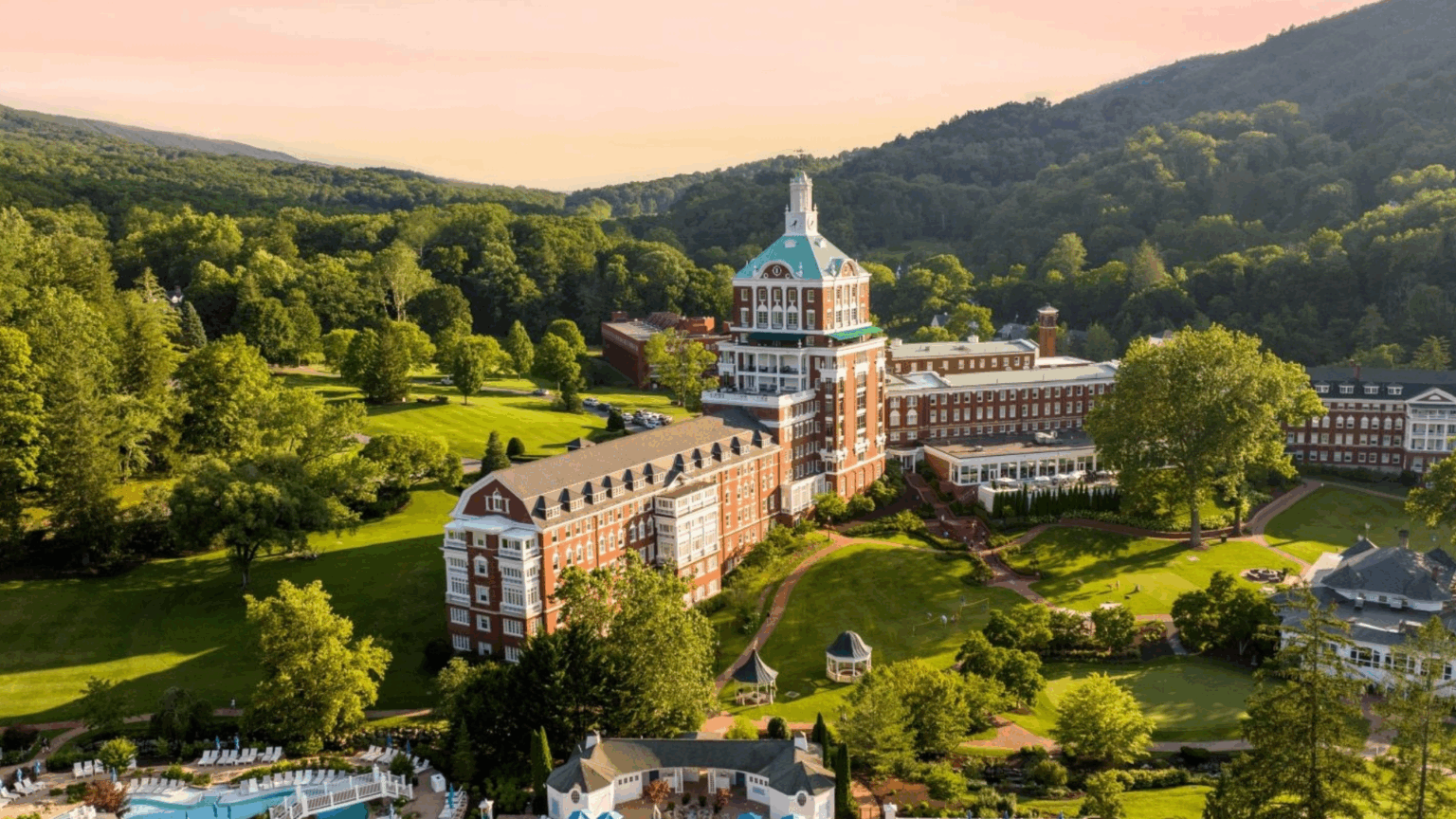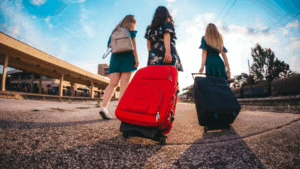The Architecture Tells a Story
Every historic hotel has significant architecture representing that period in time The bricks, beams, and arches were constructed to last a long time. Quality natural materials were used, and the builders employed the craftsmanship and style of the time in the architectural design.
The Omni Homestead Resort in Hot Springs, Virginia, is a great example. Originally opened in 1766, the property has hosted 23 U.S. presidents, and its colonnaded verandas and Jeffersonian architecture showcase the nation’s earliest leisure travel traditions. Today, you can still soak in the same mineral springs the same mineral springs that drew visitors centuries ago. The difference is modern-day guests also enjoy golf courses with manicured lawns, up-to-date indoor spas, and ski slopes with modern ski lifts, rentals, and other amenities.
At Hotel Monteleone in New Orleans, another historic hotel, the Beaux-Arts style frames a hotel that has been a literary destination since the early 20th century. Truman Capote claimed he was born there (albeit not true), and the revolving and flashy Carousel Bar is as iconic as the building itself.
Rooms With a Past
One of the most captivating aspects of historic hotels is knowing the history. It makes the visit even more exciting, especially if you are a fan of the person’s work or if he or she made a powerful impact on your life. The room you sleep in may have once housed an entertainer, royalty, or revolutionary.
At The Stanley Hotel in Estes Park, Colorado, the inspiration for Stephen King’s “The Shining”, you can sleep in Room 217, where the author stayed. To think, his stay there impaired the novel, and later the movie! Even today, the staff often share tales of old-world eccentricities which is part of the allure, from original furnishings to creaky floors that seem to have a memory of their own.
The Palmer House in Chicago is another standout historic hotel. Originally opened in 1871, it was rebuilt after the Great Chicago Fire and has been continuously operating ever since. It has Art Deco interiors containing sweeping staircases, which have welcomed all types of celebrities from Oscar Wilde to Frank Sinatra. Today, it blends historical charm with Hilton-level amenities, offering travelers a bridge between eras.
Staff as Storytellers
One of the often-overlooked gems of a historic hotel stay is the staff. In many of these properties, team members double as historians. They will tell you who painted that portrait in the hallway, when the ballroom ceiling was last restored, or which famous guest refused to leave until their bathtub was filled with champagne.
At the Grand Hotel on Mackinac Island in Michigan, bellmen often recount the island’s car-free history and how the hotel’s 660-foot porch became the longest in the world. Guests are encouraged to dress up for dinner, continuing the tradition of refinement that defined 19th-century vacation culture. Here, nostalgia isn’t a theme; it’s a way of life.
You don’t just stay at these places—you learn. It’s a more immersive kind of hospitality, one that invites you to slow down and ask questions.
Dining in a Bygone Era
There’s something about sipping a cocktail in a velvet booth under a crystal chandelier that makes you feel like you’re part of a different time. Many historic hotels take their dining seriously, honoring recipes and traditions from the past.
The Brown Hotel in Louisville, Kentucky, is home to the legendary Hot Brown sandwich—a decadent open-faced turkey sandwich with bacon and Mornay sauce, created at the hotel in the 1920s to feed hungry jazz-age partygoers. The dining room still features opulent ceiling moldings and gold-leaf decor that echo the spirit of the Roaring Twenties.
In Boston, the Omni Parker House claims to have invented Boston cream pie and once employed a young Ho Chi Minh as a pastry chef. Meals here come with a side of storytelling, and that’s part of what makes the experience so memorable.
When Luxury and History Meet
Not every historic hotel is a time capsule. Many blend tradition with transformation. These hotels have kept their soul while updating their offerings to meet modern standards.
The Jefferson Hotel in Richmond, Virginia, is a perfect example. Built in 1895 and fully restored in the 1990s, it still features Tiffany stained-glass windows and a grand staircase rumored to have inspired the one in Gone with the Wind. But it also includes top-rated restaurants, a luxe spa, and Wi-Fi strong enough for remote workers. It’s living proof that historic doesn’t have to mean outdated.
This balance of old and new is why historic hotels are growing in popularity. Travelers are craving experiences that feel rooted, not just Instagrammable. According to a 2023 report by the National Trust for Historic Preservation, bookings at heritage hotels have steadily increased among Gen Z and millennial travelers, who are more likely to value storytelling, design, and sustainability over sheer novelty.
Ghosts, Myths, and Legends
Some historic hotels lean into their spooky reputations—and guests love it. Whether or not you believe in the paranormal, stories of hauntings add another layer to the stay.
The Crescent Hotel in Eureka Springs, Arkansas, calls itself “America’s Most Haunted Hotel.” Once a hospital and a women’s conservatory, it’s now a restored Victorian-era hotel where ghost tours are as popular as the spa treatments. Staff and guests alike report flickering lights, phantom footsteps, and otherworldly sightings.
At California’s Queen Mary, a former ocean liner turned hotel, visitors can sleep in Art Deco cabins once used by WWII troops and celebrities alike. Ghost tours run nightly, and historical docents offer background on the ship’s more dignified years.
Hauntings aside, these tales keep history alive, making guests feel like they’re part of something bigger than their booking confirmation.
Events That Resurrect the Past
Many historic hotels don’t just preserve history—they reenact it. From costumed galas to vintage afternoon teas, these curated events transport guests back in time with flair and fidelity.
At the Châteauesque-inspired Hotel del Coronado in San Diego, guests can attend themed soirées that harken back to the turn of the 20th century. The hotel has hosted U.S. presidents, Marilyn Monroe, and even royalty, and its beachfront setting adds a touch of Gilded Age glamour to any gathering. Annual events like the “Victorian Tea by the Sea” offer period-appropriate menus, live harpists, and staff dressed in Edwardian attire.
The Greenbrier in West Virginia, with its antebellum charm and Dorothy Draper interiors, takes things even further. The resort has a long history as a Cold War-era fallout shelter and has embraced its dual identity by offering bunker tours alongside ballroom dancing events. In summer months, croquet tournaments on manicured lawns and patriotic parades tap into traditions that stretch back generations.
These events offer more than just entertainment—they deepen your connection to the location. Guests aren’t just observers; they become participants in a living history. Whether it’s a Prohibition-themed cocktail night or a historic walking tour guided by an in-character “guest from 1925,” these experiences add authenticity and fun.
The appeal of these events lies in their attention to detail. From vintage menus to period music, everything is designed to be historically immersive. It’s not cosplay—it’s cultural heritage made engaging. And for travelers seeking meaning over modernity, these events become the highlight of their trip.
A Different Kind of Sustainability
Historic hotels aren’t just preserving the past for romance—they’re doing it for the planet. By restoring and repurposing existing structures, these properties are inherently more sustainable than building new ones from scratch.
Take The Inn at the Presidio in San Francisco. Housed in a former military barracks dating back to 1903, the building was meticulously renovated with reclaimed materials, energy-efficient systems, and a focus on adaptive reuse. Guests sleep in rooms with original hardwood floors and brass fixtures—but enjoy amenities like solar panels and low-flow water systems.
The concept is simple: reusing what already exists reduces waste, preserves craftsmanship, and maintains local character. In a world of prefab hotels that feel the same in every city, historic properties offer something more grounded and responsible.
Moreover, many of these hotels support local economies through small-scale sourcing and community partnerships. At Blantyre in Lenox, Massachusetts—a Tudor-style mansion turned luxury retreat—farm-to-table dining isn’t a trend; it’s tradition. Much of the produce is grown on surrounding farms, and staff are often long-time residents of the area, keeping money and heritage local.
Sustainability also means cultural sustainability: preserving stories, architecture, and customs that might otherwise fade. Historic hotels become stewards of regional identity, offering guests a travel experience that’s both lighter on the environment and richer in meaning.
This growing awareness has made heritage travel especially popular among younger generations. Guests who care about carbon footprints, local sourcing, and meaningful impact are finding that a night in a historic hotel offers more than charm—it offers conscience.
Why Travelers Keep Coming Back
The appeal of historic hotels is more than nostalgia. It’s about experience. In a world of minimalist design and contactless check-ins, there’s something refreshing about entering a room with character, warmth, and layers of history.
Travelers come for the ambiance but stay for the stories. Historic hotels offer more than a place to rest—they provide a setting for memory-making. And whether you’re curling up in a four-poster bed, wandering candlelit halls, or attending high tea under vaulted ceilings, the past suddenly feels present.
TLDR: Historic Hotels Worth Checking Into
- Historic hotels combine immersive storytelling with authentic design
- Many were once homes to presidents, writers, or cultural icons
- Staff often act as storytellers and local historians
- Dining traditions and signature dishes connect you to the past
- Properties balance elegance with modern comforts
- Ghost stories add charm and intrigue
- Guests return not just for the amenities, but for the atmosphere
















